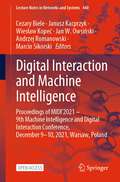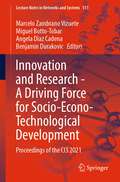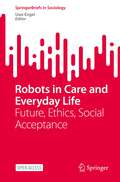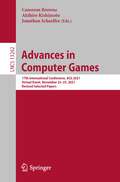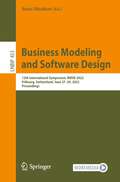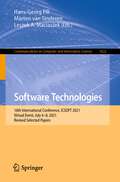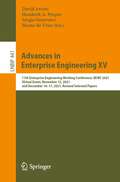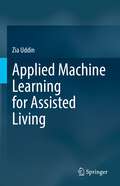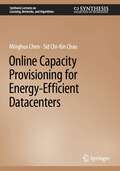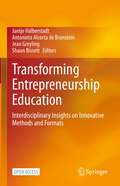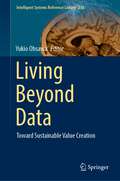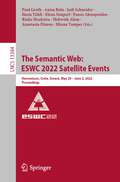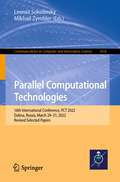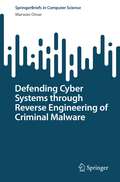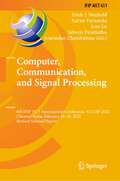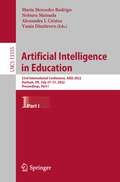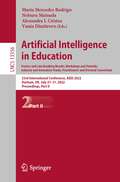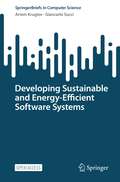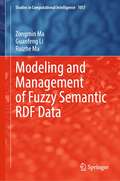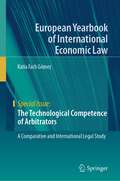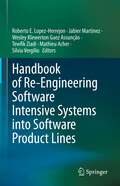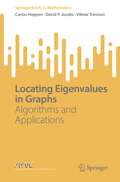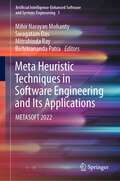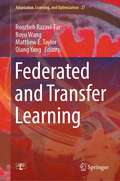- Table View
- List View
Digital Interaction and Machine Intelligence: Proceedings of MIDI’2021 – 9th Machine Intelligence and Digital Interaction Conference, December 9-10, 2021, Warsaw, Poland (Lecture Notes in Networks and Systems #440)
by Cezary Biele Janusz Kacprzyk Wiesław Kopeć Jan W. Owsiński Andrzej Romanowski Marcin SikorskiThis book is open access, which means that you have free and unlimited access.This book presents the Proceedings of the 9th Machine Intelligence and Digital Interaction Conference. Significant progress in the development of artificial intelligence (AI) and its wider use in many interactive products are quickly transforming further areas of our life, which results in the emergence of various new social phenomena. Many countries have been making efforts to understand these phenomena and find answers on how to put the development of artificial intelligence on the right track to support the common good of people and societies. These attempts require interdisciplinary actions, covering not only science disciplines involved in the development of artificial intelligence and human-computer interaction but also close cooperation between researchers and practitioners. For this reason, the main goal of the MIDI conference held on 9-10.12.2021 as a virtual event is to integrate two, until recently, independent fields of research in computer science: broadly understood artificial intelligence and human-technology interaction.
Innovation and Research - A Driving Force for Socio-Econo-Technological Development: Proceedings of the CI3 2021 (Lecture Notes in Networks and Systems #511)
by Marcelo Zambrano Vizuete Miguel Botto-Tobar Angela Diaz Cadena Benjamin DurakovicThis book presents the proceedings of the 2nd International Congress on Innovation and Research—A Driving Force for Socio-Econo-Technological Development (CI3 2021). CI3 was held on September 1–3, 2021. It was organized by the Instituto Tecnológico Superior Rumiñahui and GDEON, in co-organization with Higher Institutes: Bolivariano de Tecnología, Central Técnico, Espíritu Santo, José Chiriboga Grijalva, ISMAC, Policía Nacional del Ecuador Vida Nueva; and sponsored by the Universidad Nacional Mayor de San Marcos (Peru), Universidade Federal de Goiás (Brazil) and City University of New York (United States). CI3 aims to disseminate the research project results that are being carried out in different Higher Education Institutions, research centers, and the business sector.
Robots in Care and Everyday Life: Future, Ethics, Social Acceptance (SpringerBriefs in Sociology)
by Uwe EngelThis open access book presents detailed findings about the ethical, legal, and social acceptance of robots in the German and European context. The key resource is the Bremen AI Delphi survey of scientists and politicians and a related population survey. The focus is on trust in robotic assistance, human willingness to use this assistance, and the expected personal well-being in human-robot interaction. Using recent data from Eurostat, the European Social Survey, and the Eurobarometer survey, the analysis is extended to Germany and the EU. The acceptance of robots in care and everyday life is viewed against their acceptance in other contexts of life and the scientific research. The book reports on how the probability of five complex future scenarios is evaluated by experts and politicians. These scenarios cover a broad range of topics, including the worst-case scenario of cutthroat competition for jobs, the wealth promise of AI, communication in human-robot interaction, robotic assistance, and ethical and legal conflicts. International economic competition alone will ensure that countries invest sustainably in the future technologies of AI and robots. But will these technologies also be accepted by the population? The book raises the core issue of how governments can gain the needed social, ethical, and user acceptance of AI and robots in everyday life. This highly topical book is of interest to researchers, professionals and policy makers working on various aspects of human-robot interaction. This is an open access book.
Advances in Computer Games: 17th International Conference, ACG 2021, Virtual Event, November 23–25, 2021, Revised Selected Papers (Lecture Notes in Computer Science #13262)
by Cameron Browne Akihiro Kishimoto Jonathan SchaefferThis book constitutes the refereed post-conference proceedings of the 17th International Conference on Advances in Computer Games, ACG 2021, which was held as a virtual event during November 23–25, 2021. The 22 full papers included in this book were carefully reviewed and selected from 34 submissions. They were organized in topical sections as follows: learning in games; search in games; solving games; chess patterns; player modelling; and game systems.
Business Modeling and Software Design: 12th International Symposium, BMSD 2022, Fribourg, Switzerland, June 27–29, 2022, Proceedings (Lecture Notes in Business Information Processing #453)
by Boris ShishkovThis book constitutes the refereed proceedings of the 12h International Symposium on Business Modeling and Software Design, BMSD 2022, which took place in Fribourg, Switzerland, in June 2022.The 12 full and 9 short papers included in this book were carefully reviewed and selected from a total of 56 submissions. BMSD is a leading international forum that brings together researchers and practitioners interested in business modeling and its relation to software design. Particular areas of interest are: Business Processes and Enterprise Engineering; Business Models and Requirements; Business Models and Services; Business Models and Software; Information Systems Architectures and Paradigms; Data Aspects in Business Modeling and Software Development; Blockchain-Based Business Models and Information Systems; IoT and Implications for Enterprise Information Systems. Each year, a special theme is chosen, for making presentations and discussions more focused. The BMSD 2022 theme is: Information Systems Engineering and Trust.
Software Technologies: 16th International Conference, ICSOFT 2021, Virtual Event, July 6–8, 2021, Revised Selected Papers (Communications in Computer and Information Science #1622)
by Hans-Georg Fill Marten Van Sinderen Leszek A. MaciaszekThis book constitutes the refereed proceedings of the 16th International Conference on Software Technologies, ICSOFT 2021, Virtual Event, July 6–8, 2021. The conference was held virtually due to the COVID-19 crisis.The 10 full papers included in this book were carefully reviewed and selected from 117 submissions.
Advances in Enterprise Engineering XV: 11th Enterprise Engineering Working Conference, EEWC 2021, Virtual Event, November 12, 2021, and December 16–17, 2021, Revised Selected Papers (Lecture Notes in Business Information Processing #441)
by David Aveiro Henderik A. Proper Sérgio Guerreiro Marne De VriesThis book constitutes the proceedings of the 11th Enterprise Engineering Working Conference, EEWC 2021, which was held online on November 12, 2021, and December 16-17, 2021.EEWC aims at addressing the challenges that modern and complex enterprises are facing in a rapidly changing world. The participants of the working conference share a belief that dealing with these challenges requires rigorous and scientific solutions, focusing on the design and engineering of enterprises. The goal of EEWC is to stimulate interaction between the different stakeholders, scientists as well as practitioners, interested in making Enterprise Engineering a reality. The 5 full papers and 3 short papers presented in this volume were carefully reviewed and selected from 16 submissions. The volume also contains 2 keynote papers.
Applied Machine Learning for Assisted Living
by Zia UddinUser care at home is a matter of great concern since unforeseen circumstances might occur that affect people's well-being. Technologies that assist people in independent living are essential for enhancing care in a cost-effective and reliable manner. Assisted care applications often demand real-time observation of the environment and the resident’s activities using an event-driven system. As an emerging area of research and development, it is necessary to explore the approaches of the user care system in the literature to identify current practices for future research directions. Therefore, this book is aimed at a comprehensive review of data sources (e.g., sensors) with machine learning for various smart user care systems. To encourage the readers in the field, insights of practical essence of different machine learning algorithms with sensor data (e.g., publicly available datasets) are also discussed. Some code segments are also included to motivate the researchers of the related fields to practically implement the features and machine learning techniques. It is an effort to obtain knowledge of different types of sensor-based user monitoring technologies in-home environments. With the aim of adopting these technologies, research works, and their outcomes are reported. Besides, up to date references are included for the user monitoring technologies with the aim of facilitating independent living.Research that is related to the use of user monitoring technologies in assisted living is very widespread, but it is still consists mostly of limited-scale studies. Hence, user monitoring technology is a very promising field, especially for long-term care. However, monitoring of the users for smart assisted technologies should be taken to the next level with more detailed studies that evaluate and demonstrate their potential to contribute to prolonging the independent living of people. The target of this book is to contribute towards that direction.
British Versions of Book II of Euclid’s Elements: Geometry, Arithmetic, Algebra (SpringerBriefs in History of Science and Technology)
by Leo CorryThis book discusses the changing conceptions about the relationship between geometry and arithmetic within the Euclidean tradition that developed in the British context of the sixteenth and seventeenth century. Its focus is on Book II of the Elements and the ways in which algebraic symbolism and methods, especially as recently introduced by François Viète and his followers, took center stage as mediators between the two realms, and thus offered new avenues to work out that relationship in idiosyncratic ways not found in earlier editions of the Euclidean text. Texts examined include Robert Recorde's Pathway to Knowledge (1551), Henry Billingsley’s first English translation of the Elements (1570), Clavis Mathematicae by William Oughtred and Artis Analyticae Praxis by Thomas Harriot (both published in 1631), Isaac Barrow’s versions of the Elements (1660), and John Wallis Treatise of Algebra (1685), and the English translations of Claude Dechales’ French Euclidean Elements (1685). This book offers a completely new perspective of the topic and analyzes mostly unexplored material. It will be of interest to historians of mathematics, mathematicians with an interest in history and historians of renaissance science in general.
Online Capacity Provisioning for Energy-Efficient Datacenters (Synthesis Lectures on Learning, Networks, and Algorithms)
by Minghua Chen Sid Chi-Kin ChauThis book addresses the urgent issue of massive and inefficient energy consumption by data centers, which have become the largest co-located computing systems in the world and process trillions of megabytes of data every second. Dynamic provisioning algorithms have the potential to be the most viable and convenient of approaches to reducing data center energy consumption by turning off unnecessary servers, but they incur additional costs from being unable to properly predict future workload demands that have only recently been mitigated by advances in machine-learned predictions.This book explores whether it is possible to design effective online dynamic provisioning algorithms that require zero future workload information while still achieving close-to-optimal performance. It also examines whether characterizing the benefits of utilizing the future workload information can then improve the design of online algorithms with predictions in dynamic provisioning. The book specifically develops online dynamic provisioning algorithms with and without the available future workload information. Readers will discover the elegant structure of the online dynamic provisioning problem in a way that reveals the optimal solution through divide-and-conquer tactics. The book teaches readers to exploit this insight by showing the design of two online competitive algorithms with competitive ratios characterized by the normalized size of a look-ahead window in which exact workload prediction is available.
Transforming Entrepreneurship Education: Interdisciplinary Insights on Innovative Methods and Formats
by Jantje Halberstadt Antonieta Alcorta de Bronstein Jean Greyling Shaun BissettThis open access book provides selected teaching approaches, supporting methods, concrete examples of curricula as well as extracurricular teaching formats, which are predominantly tailored to both African and German requirements. These approaches were developed by the YEEES Training and Research Centers, an international interdisciplinary network of university teachers and researchers from Germany and southern Africa, and combine the fields of management, entrepreneurship, information and communication technologies (ICT), and sustainability. The book shows how current scientific results can be integrated into teaching, how students can contribute to research while learning, and how research can contribute to the development and evaluation of new formats. It is thus relevant for university teachers, researchers, students as well as practitioners who want to educate and act as future change agents.
Living Beyond Data: Toward Sustainable Value Creation (Intelligent Systems Reference Library #230)
by Yukio OhsawaThis book states that data users often suffer from the difficulty of acquiring knowledge for decision-making, and others are unsure how existing data are useful. The reader will be released from these dilemmas and enabled to act beyond patterns in past events by creating a process to interact with the data market and the dynamic real-world rich in new events. We present new approaches from the aspects of computation, communication, and their integration, to readers including analysts in sciences and businesses, systems managers, and learners desiring to design knowledge to learn. We show clues to explaining causalities in the target world of a black-box AI of which users may seek a predictive performance. For obtaining interpretable knowledge, we show the integration of model- and data-driven approaches, the analysis and perception of signals from data acquired in the cyber or the real word, and creative communication which connects demands to data by visualizing the data market as a place for innovations
The Semantic Web: Hersonissos, Crete, Greece, May 29 – June 2, 2022, Proceedings (Lecture Notes in Computer Science #13384)
by Paul Groth Anisa Rula Jodi Schneider Ilaria Tiddi Elena Simperl Panos Alexopoulos Rinke Hoekstra Mehwish Alam Anastasia Dimou Minna TamperThis book constitutes the proceedings of the satellite events held at the 19th Extended Semantic Web Conference, ESWC 2022, during May—June in Hersonissos, Greece, 2022. The included satellite events are: the poster and demo session; the PhD symposium; industry track; project networking; workshops and tutorials. During ESWC 2022, the following ten workshops took place:10th Linked Data in Architecture and Construction Workshop (LDAC 2022); 5th International Workshop on Geospatial Linked Data (GeoLD 2022); 5th Workshop on Semantic Web solutions for large-scale biomedical data analytics (SeMWeBMeDA 2022); 7th Natural Language Interfaces for the Web of Data (NLIWOD+QALD 2022); International Workshop on Knowledge Graph Generation from Text (Text2KG 2022); 3rd International Workshop on Deep Learning meets Ontologies and Natural Language Processing (DeepOntoNLP 2022); 1st Workshop on Modular Knowledge (ModularK 2022); Third International Workshop On Knowledge Graph Construction (KGCW 2022); Third International Workshop On Semantic Digital Twins (SeDIT 2022); and the 1st International Workshop on Semantic Industrial Information Modelling (SemIIM 2022).
Parallel Computational Technologies: 16th International Conference, PCT 2022, Dubna, Russia, March 29–31, 2022, Revised Selected Papers (Communications in Computer and Information Science #1618)
by Leonid Sokolinsky Mikhail ZymblerThis book constitutes the refereed proceedings of the 16th International Conference on Parallel Computational Technologies, PCT 2022, held in Dubna, Russia, during March 29–31, 2022.The 22 full papers included in this book were carefully reviewed and selected from 60 submissions. They were organized in topical sections as follows: high performance architectures, tools and technologies; parallel numerical algorithms; supercomputer simulation.
Defending Cyber Systems through Reverse Engineering of Criminal Malware (SpringerBriefs in Computer Science)
by Marwan OmarThis SpringerBrief discusses underlying principles of malware reverse engineering and introduces the major techniques and tools needed to effectively analyze malware that targets business organizations. It also covers the examination of real-world malware samples, which illustrates the knowledge and skills necessary to take control of cyberattacks.This SpringerBrief explores key tools and techniques to learn the main elements of malware analysis from the inside out. It also presents malware reverse engineering using several methodical phases, in order to gain a window into the mind set of hackers. Furthermore, this brief examines malicious program’s behavior and views its code-level patterns. Real world malware specimens are used to demonstrate the emerging behavioral patterns of battlefield malware as well.This SpringerBrief is unique, because it demonstrates the capabilities of emerging malware by conducting reverse-code engineering on real malware samples and conducting behavioral analysis in isolated lab system. Specifically, the author focuses on analyzing malicious Windows executables. This type of malware poses a large threat to modern enterprises. Attackers often deploy malicious documents and browser-based exploits to attack Windows enterprise environment. Readers learn how to take malware inside-out using static properties analysis, behavioral analysis and code-level analysis techniques.The primary audience for this SpringerBrief is undergraduate students studying cybersecurity and researchers working in this field. Cyber security professionals that desire to learn more about malware analysis tools and techniques will also want to purchase this SpringerBrief.
Computer, Communication, and Signal Processing: 6th IFIP TC 5 International Conference, ICCCSP 2022, Chennai, India, February 24–25, 2022, Revised Selected Papers (IFIP Advances in Information and Communication Technology #651)
by Erich J. Neuhold Xavier Fernando Joan Lu Selwyn Piramuthu Aravindan ChandraboseThis book constitutes the refereed proceedings of the 6th International Conference on Computer, Communication, and Signal Processing, ICCSP 2022, held in Chennai, India, in February 2022.* The 21 full and 2 short papers presented in this volume were carefully reviewed and selected from 111 submissions. The papers are categorized into topical sub-headings: artificial intelligence and machine learning; Cyber security; and internet of things.*The conference was held as a virtual event due to the COVID-19 pandemic.
Artificial Intelligence in Education: 23rd International Conference, AIED 2022, Durham, UK, July 27–31, 2022, Proceedings, Part I (Lecture Notes in Computer Science #13355)
by Maria Mercedes Rodrigo Noburu Matsuda Alexandra I. Cristea Vania DimitrovaThis two-volume set LNAI 13355 and 13356 constitutes the refereed proceedings of the 23rd International Conference on Artificial Intelligence in Education, AIED 2022, held in Durham, UK, in July 2022.The 40 full papers and 40 short papers presented together with 2 keynotes, 6 industry papers, 12 DC papers, 6 Workshop papers, 10 Practitioner papers, 97 Posters and Late-Breaking Results were carefully reviewed and selected from 243 submissions. The conference presents topics such as intelligent systems and the cognitive sciences for the improvement and advancement of education, the science and engineering of intelligent interactive learning systems. The theme for the AIED 2022 conference was „AI in Education: Bridging the gap between academia, business, and non-pro t in preparing future-proof generations towards ubiquitous AI."
Artificial Intelligence in Education. Posters and Late Breaking Results, Workshops and Tutorials, Industry and Innovation Tracks, Practitioners’ and Doctoral Consortium: 23rd International Conference, AIED 2022, Durham, UK, July 27–31, 2022, Proceedings, Part II (Lecture Notes in Computer Science #13356)
by Maria Mercedes Rodrigo Noburu Matsuda Alexandra I. Cristea Vania DimitrovaThis two-volume set LNAI 13355 and 13356 constitutes the refereed proceedings of the 23rd International Conference on Artificial Intelligence in Education, AIED 2022, held in Durham, UK, in July 2022.The 40 full papers and 40 short papers presented together with 2 keynotes, 6 industry papers, 12 DC papers, 6 Workshop papers, 10 Practitioner papers, 97 Posters and Late-Breaking Results were carefully reviewed and selected from 243 submissions. The conference presents topics such as intelligent systems and the cognitive sciences for the improvement and advancement of education, the science and engineering of intelligent interactive learning systems. The theme for the AIED 2022 conference was „AI in Education: Bridging the gap between academia, business, and non-pro t in preparing future-proof generations towards ubiquitous AI."
Developing Sustainable and Energy-Efficient Software Systems (SpringerBriefs in Computer Science)
by Artem Kruglov Giancarlo SucciThis open access book provides information how to choose and collect the appropriate metrics for a software project in an organization. There are several kinds of metrics, based on the analysis of source code and developed for different programming paradigms such as structured programming and object-oriented programming (OOP). This way, the book follows three main objectives: (i) to identify existing and easily-collectible measures, if possible in the early phases of software development, for predicting and modeling both the traditional attributes of software systems and attributes specifically related to their efficient use of resources, and to create new metrics for such purposes; (ii) to describe ways to collect these measures during the entire lifecycle of a system, using minimally-invasive monitoring of design-time processes, and consolidate them into conceptual frameworks able to support model building by using a variety of approaches, including statistics, data mining and computational intelligence; and (iii) to present models and tools to support design time evolution of systems based on design-time measures and to empirically validate them. The book provides researchers and advanced professionals with methods for understanding the full implications of alternative choices and their relative attractiveness in terms of enhancing system resilience. It also explores the simultaneous use of multiple models that reflect different system interpretations or stakeholder perspectives.
Modeling and Management of Fuzzy Semantic RDF Data (Studies in Computational Intelligence #1057)
by Zongmin Ma Guanfeng Li Ruizhe MaThis book systemically presents the latest research findings in fuzzy RDF data modeling and management. Fuzziness widely exist in many data and knowledge intensive applications. With the increasing amount of metadata available, efficient and scalable management of massive semantic data with uncertainty is of crucial importance. This book goes to great depth concerning the fast-growing topic of technologies and approaches of modeling and managing fuzzy metadata with Resource Description Framework (RDF) format. Its major topics include representation of fuzzy RDF data, fuzzy RDF graph matching, query of fuzzy RDF data, and persistence of fuzzy RDF data in diverse databases. The objective of the book is to provide the state-of-the-art information to researchers, practitioners, and postgraduates students who work on the area of big data intelligence and at the same time serve as the uncertain data and knowledge engineering professional as a valuable real-world reference.
The Technological Competence of Arbitrators: A Comparative and International Legal Study (European Yearbook of International Economic Law)
by Katia Fach GómezArbitration is facing revolutionary changes due to new technologies’ irruption into the entire arbitration proceeding. Wide-ranging technical-legal concepts such as e-discovery, e-hearing, cyber-security protocol, e-deliberations, algorithmic decision-making and digital signing have become part of life. Technology’s impact on arbitration is unlikely to decrease after the COVID crisis; on the contrary, how the arbitration community positions itself vis-à-vis technology will be a key factor in determining arbitration’s future. Faced with this challenging scenario, the book discusses a novel legal topic: arbitrators’ relationship with this increasingly ubiquitous, rapidly-changing technology. This innovative book applies journalism’s “5 W questions” to the underexplored issue of arbitrators’ digital competence. It reaches a workable definition of what digital competence in the current arbitration context is, also providing answers to the essential question of why arbitrators’ digital competence is relevant from legal and financial points of view. Attention then shifts to who, with reflections on arbitrators working in a highly technological context and clarification of their relationship with other legal and non-legal actors. The book equally offers an in-depth comparative study of the question of where arbitrators’ technological competence is regulated, with critical analysis of soft and hard law provisions that may impose a digital competence duty. Finally, the book specifies when arbitrators need to be digitally competent and develops legal proposals regarding key procedural stages (initial conference, hearings) and legal topics (cybersecurity, data protection). The first study to scrutinise the rapidly changing relationship between arbitrators and technology, the book aims to spark a crucial debate among practitioners and scholars. Academically rigorous and using the latest legal material, it emphasises arbitrators’ needs, rights and duties in our technological age, presenting them alongside carefully selected practical topics. The unprecedented and well-grounded proposals for arbitrators’ digital competence are intended to be a call to action for its broad target audience.
Handbook of Re-Engineering Software Intensive Systems into Software Product Lines
by Roberto E. Lopez-Herrejon Jabier Martinez Wesley Klewerton Guez Assunção Tewfik Ziadi Mathieu Acher Silvia VergilioThis handbook distils the wealth of expertise and knowledge from a large community of researchers and industrial practitioners in Software Product Lines (SPLs) gained through extensive and rigorous theoretical, empirical, and applied research. It is a timely compilation of well-established and cutting-edge approaches that can be leveraged by those facing the prevailing and daunting challenge of re-engineering their systems into SPLs. The selection of chapters provides readers with a wide and diverse perspective that reflects the complementary and varied expertise of the chapter authors. This perspective covers the re-engineering processes, from planning to execution.SPLs are families of systems that share common assets, allowing a disciplined software reuse. The adoption of SPL practices has shown to enable significant technical and economic benefits for the companies that employ them. However, successful SPLs rarely start from scratch, but instead, they usually start from a set of existing systems that must undergo well-defined re-engineering processes to unleash new levels of productivity and competitiveness.Practitioners will benefit from the lessons learned by the community, captured in the array of methodological and technological alternatives presented in the chapters of the handbook, and will gain the confidence for undertaking their own re-engineering challenges. Researchers and educators will find a valuable single-entry point to quickly become familiar with the state-of-the-art on the topic and the open research opportunities; including undergraduate, graduate students, and R&D engineers who want to have a comprehensive understanding of techniques in reverse engineering and re-engineering of variability-rich software systems.
Locating Eigenvalues in Graphs: Algorithms and Applications (SpringerBriefs in Mathematics)
by Carlos Hoppen David P. Jacobs Vilmar TrevisanThis book focuses on linear time eigenvalue location algorithms for graphs. This subject relates to spectral graph theory, a field that combines tools and concepts of linear algebra and combinatorics, with applications ranging from image processing and data analysis to molecular descriptors and random walks. It has attracted a lot of attention and has since emerged as an area on its own.Studies in spectral graph theory seek to determine properties of a graph through matrices associated with it. It turns out that eigenvalues and eigenvectors have surprisingly many connections with the structure of a graph. This book approaches this subject under the perspective of eigenvalue location algorithms. These are algorithms that, given a symmetric graph matrix M and a real interval I, return the number of eigenvalues of M that lie in I. Since the algorithms described here are typically very fast, they allow one to quickly approximate the value of any eigenvalue, which is a basic step in most applications of spectral graph theory. Moreover, these algorithms are convenient theoretical tools for proving bounds on eigenvalues and their multiplicities, which was quite useful to solve longstanding open problems in the area. This book brings these algorithms together, revealing how similar they are in spirit, and presents some of their main applications.This work can be of special interest to graduate students and researchers in spectral graph theory, and to any mathematician who wishes to know more about eigenvalues associated with graphs. It can also serve as a compact textbook for short courses on the topic.
Meta Heuristic Techniques in Software Engineering and Its Applications: METASOFT 2022 (Artificial Intelligence-Enhanced Software and Systems Engineering #1)
by Mihir Narayan Mohanty Swagatam Das Mitrabinda Ray Bichitrananda PatraThis book discusses an integration of machine learning with metaheuristic techniques that provide more robust and efficient ways to address traditional optimization problems. Modern metaheuristic techniques, along with their main characteristics and recent applications in artificial intelligence, software engineering, data mining, planning and scheduling, logistics and supply chains, are discussed in this book and help global leaders in fast decision making by providing quality solutions to important problems in business, engineering, economics and science. Novel ways are also discovered to attack unsolved problems in software testing and machine learning. The discussion on foundations of optimization and algorithms leads beginners to apply current approaches to optimization problems. The discussed metaheuristic algorithms include genetic algorithms, simulated annealing, ant algorithms, bee algorithms and particle swarm optimization. New developments on metaheuristics attract researchers and practitioners to apply hybrid metaheuristics in real scenarios.
Federated and Transfer Learning (Adaptation, Learning, and Optimization #27)
by Roozbeh Razavi-Far Boyu Wang Matthew E. Taylor Qiang YangThis book provides a collection of recent research works on learning from decentralized data, transferring information from one domain to another, and addressing theoretical issues on improving the privacy and incentive factors of federated learning as well as its connection with transfer learning and reinforcement learning. Over the last few years, the machine learning community has become fascinated by federated and transfer learning. Transfer and federated learning have achieved great success and popularity in many different fields of application. The intended audience of this book is students and academics aiming to apply federated and transfer learning to solve different kinds of real-world problems, as well as scientists, researchers, and practitioners in AI industries, autonomous vehicles, and cyber-physical systems who wish to pursue new scientific innovations and update their knowledge on federated and transfer learning and their applications.
